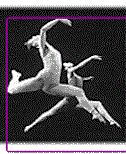C |
Pronunciation |
Description |
cabriole |
kah•BREE•ohl |
caper; leap
a beating jump
from one leg to the same leg
example: hold one
leg off the floor and then jump up with the supporting leg , beat it against the other and
land back on the original supporting leg
|
chaîné |
shah•NAY |
to chain;
series of
connected movements
example: make
half-turns in 1st position traveling to the side very quickly
|
changé |
shahn•ZJAY |
to change
|
changement |
shahnzj•MAHN |
alteration
a jump from 5th
position, changing the legs and landing in 5th position
|
chassé |
shah•SAY |
to glide
a smooth gliding
movement that can be done either front, side or back
example: with one
leg in the front and extended forward of the other leg - step forward on the extended leg,
pull both legs together traveling forward in the air, then land on the back leg with front
leg extended forward
|
chat, pas de |
pah duh shah |
step of the cat
a jump from one
foot to the other and when in the air both feet are off the ground
example: right leg
front 5th position - pull the right leg up sharply to the knee and then extend it to the
side with the knee slightly bent, jump of the left leg bringing it up to meet the right
leg with its knee slightly bent, land on the right leg and then bring the left leg front
5th position
|
cheval, pas de |
pah de shuh•VAHL |
step of the horse
a movement that
can be done on the floor or as a jump, and at 45°, 90° or 120°
example: right leg
front 5th position - pull the right leg up sharply to the supporting leg's ankle, extend
it forward and touch the floor with the toes, then close it 5th position front
|
cinq |
sank |
five
|
cinquième |
sank•ee•em |
fifth
|
ciseaux, pas de |
pah deh see•ZJOH |
scissors; step of the scissors
a jump from one
leg where both legs pass each other forward in the air and landing on one leg
example: step on
left leg, pass right leg through 1st position to the front 45° or 90° off the floor,
jump up with the left leg passing the right leg, then land on the right leg and pass the
left leg through 1st position to the back 45° or 90° off the floor
|
cloche, en |
ahn klohsh |
bell; as a bell
a rocking,
swinging motion like a bell
example:
balançoire en cloche - execute balançoire but with the upper torso swinging in large
arcs in the opposite direction of the leg
|
contretemps |
kahn•trah•TAHN |
contrary step
a step from one
direction that quickly changes to the other
example: facing
down-room corner with right leg crossed in front of the left leg - step forward on the
right leg, in a clock-wise circle move the left leg forward of the right leg and change
directions to face the other down-room corner, step on the left leg and pass the right leg
forward
|
coté, de |
deh koh•TAY |
to the side
|
cou-de-pieds, sur le |
surh leh koo•deh•pehay |
upon the neck of the foot
sur le
cou-de-pieds side, back or front
|
coupé |
koo•PAY |
to cut
a movement that
calls for the foot to be sharply pull off the floor and placed either in front or back of
the ankle
|
couru, pas |
pah koo•REW |
step to travel; to pursue
a movement that is
quick and light, traveling across the floor
example: step on
the right foot and quickly pass the left then right forward - this step can also be done
with 5 or 7 quick steps
|
croisé |
krawh•ZAY |
to cross
a position that
requires the dancer to face on the diagonal and have one leg crossed in front of the other
|
croix, en |
ahn krawh |
in a cross shape
a term used to
describe a movement that is done to the front, side, back and again side
|
 Ballet Vocabulary
Ballet Vocabulary